Magnetism and electricity: Identify, describe, and apply principles of electrostatics (static electricity)
Unit 3: Electrostatics in practice
Leigh Kleynhans
Unit outcomes
By the end of this unit you will be able to:
- Apply the principle of discharge to:
- a charged rod using ions in a flame
- ions in the atmosphere
- atmospheric electricity and the use of a lightning conductor.
What you should know
Before you start this unit, make sure you can:
- Identify the two types of charge.
- Describe how objects become charged, as covered in Subject outcome 4.2, Unit 1.
- Describe how charged objects interact and explain polarisation, as covered in Subject outcome 4.2, Unit 2.
Introduction
You have learnt how objects can become charged. In this unit you will learn how charged objects can revert to being neutral by the process of .
The principle of discharge
Excess charge can build up in objects as a result of friction. This is happening all the time in objects around us. When objects become highly charged, the excess electrons will want to move into another object so that they can move apart from each other. The most common way this can happen is when the charged object touches another object. Electrons can also jump across a relatively small gap between objects. This can be observed as a spark.
There are also other ways in which discharging can take place and these are explained below.
Discharging using ions in a flame
In dry conditions a charged ebonite rod or polythene rod will retain its charge for a long time. If the rod is to be discharged it may be done most effectively by passing it through the air above a flame. In a flame the gas molecules are vibrating very rapidly. Frequent collisions occur, and this friction causes electrons to be knocked off from some molecules. Molecules that have lost electrons are called positive . At the same time some of the free electrons may attach themselves to neutral molecules, and so form negative ions. When a charged rod is moved through the ionised air above a flame, ions of the opposite charge are attracted to the rod, and the charge on the rod becomes neutralised.
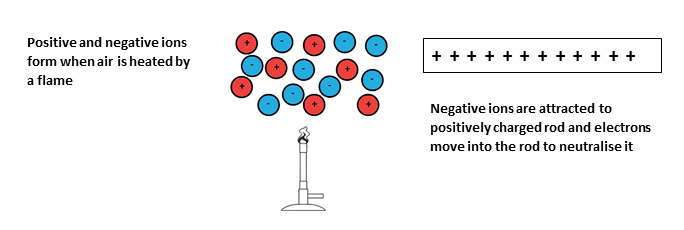
Note
Watch this video which shows the electrostatic discharge of two balloons using a flame (Duration: 1.25).

Discharging using ions in the atmosphere
by the process described above is only one way of producing gaseous ions. Various experiments have shown that the atmosphere contains ions which have been produced by radiation from minerals in the Earth’s crust, by ultraviolet light from the sun and by the so-called cosmic radiation which enters the Earth’s atmosphere from outer space.
The presence of these ions in the atmosphere explains why a charged conductor will slowly lose its charge over a period of time even when mounted on a good insulator. The charge on the conductor is gradually neutralised by ions of opposite sign which are attracted towards it out of the surrounding air.
Discharging by means of lightning
Lightning is caused by an imbalance of electric charge between the Earth and a thundercloud. Friction in the cloud causes positively and negatively charged particles to form. The positively charged particles rise above the negatively charged ones hence polarising the cloud. This in turn polarises the Earth beneath the cloud; the Earth’s surface is now positively charged.

Air is normally a very effective insulator, but in the presence of a highly charged cloud, and the high build-up of charge on the ground (i.e. a high ), its insulating properties break down. The air molecules become ionised.
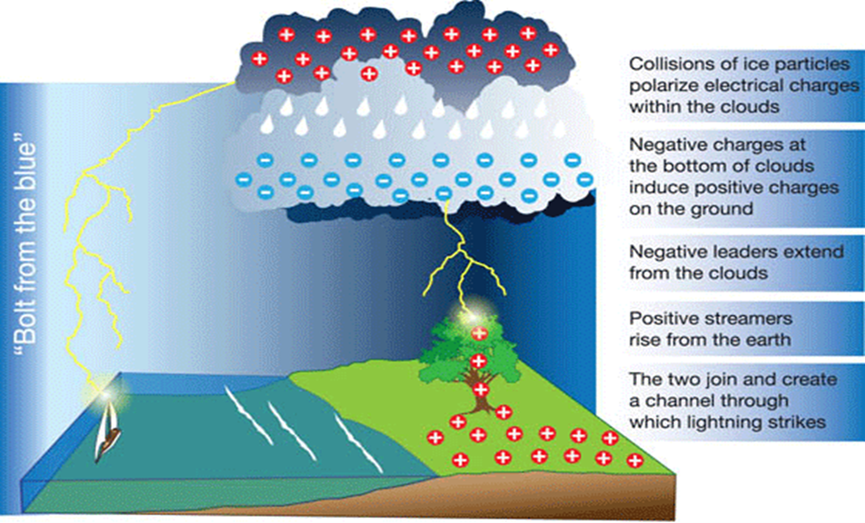
A lightning strike begins when a passage of electric charge from the cloud to the Earth meets an upward surge of charge (streamer) from the Earth to the cloud. This establishes the link from cloud to Earth.
Once that link is established the bolt of lightning strikes. In fact, there are multiple lightning strikes, happening milliseconds apart from each other. They happen so fast that we experience only the overall effect of all the strikes as ‘one’ bolt of lightning.
As the lightning streams through the air, the air heats up rapidly. Pressure waves form when the hot air expands, and these pressure waves create a that we call thunder.
Protection against lightning
Buildings and houses are protected from lightning by lightning conductors. These conductors can be steel rods placed on the roofs of buildings and connected to the ground by a piece of copper wire. They can also be steel rods placed on the ground near buildings. Streamers are much more likely to form from these higher points than the buildings and so the lightning will strike the rods. The charge then flows quickly towards the Earth. That is why people inside buildings are not harmed. The buildings with rods on them are said to be or .
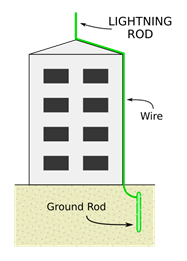
Note
Watch a video on lightning by clicking on the QR code or this link (Duration: 4.49).
Summary
In this unit you have learnt the following:
- Charged objects can become neutral by losing their charge in the process of discharging.
- Discharging can occur by contact or through ionised gas particles in the air.
- Lightning is the discharge of a build-up of charge in clouds.
- Lightning conductors can make buildings safer from lightning strikes by providing a pathway for excess charge to return to the Earth.
Unit 3: Assessment
Suggested time to complete: 15 minutes
- Explain what is meant by ‘discharging’.
- A negatively charged rod is discharged by passing it through a flame. Explain how this process occurs.
- Why does a charged object eventually lose its charge even if it is placed on an insulating stand?
- Charge separates in thunderclouds. Provide a word for this ‘separation of charge’.
- Copy the diagram below, and draw in the charge distribution on the cloud, ground, the building, the tree and the girl, just before lightning strikes.
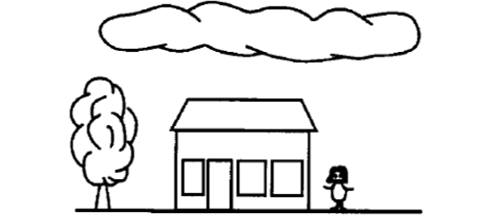
- Explain, using bullet points, how lightning develops.
- Explain how a lightning conductor protects a building.
The full solutions are at the end of the unit.
Unit 3: Solutions
Unit 3: Assessment
- Discharging occurs when a charged object gains or loses sufficient electrons to become neutral again.
- The flame ionises the air (causes some molecules to lose electrons and some to gain electrons). The positive ions will be attracted to the negatively charged rod and remove excess electrons in the rod. The rod will therefore be neutralised.
- There are ions in the atmosphere (from radioactive materials in the Earth, UV radiation from the sun or cosmic radiation from outer space). A charged object will attract oppositely charged ions to it. Electrons will then move from the ions to the object, or from the object to the ions. In this way the object will lose its excess charge and become neutral.
- Polarisation
- .
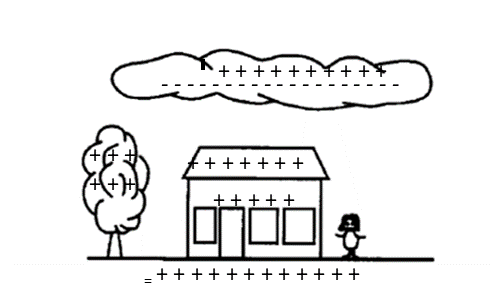
- Friction of water particles in clouds cause them to become charged.
- The cloud becomes polarised – positively charged particles move to the top and negatively charged particles move to the lower area of the cloud.
- The polarised cloud induces polarisation of the surface of the Earth, so it becomes positively charged.
- Negative charge streams from the base of the cloud meet positive streams from the Earth (or objects on the Earth).
- The two streams join forming a channel for a powerful discharge – this is a lightning bolt.
- Metal rods are placed on the roofs of buildings and connected to the ground by a piece of copper wire. Because the rods are pointed and higher than the building, streamers are much more likely to form from this point than from the building. The lightning will therefore strike the rod. The charge then flows in the copper wire quickly towards the ground and the building will be protected.
Media Attributions
- img01_Figure1 © DHET is licensed under a CC BY (Attribution) license
- QR_Code_PSL2SO42U3_2
- img02_Firgure2 © Pixabay is licensed under a CC0 (Creative Commons Zero) license
- img03_Figure3 © L Kleynhans is licensed under a CC BY (Attribution) license
- img04_Figure4 © L Kleynhans is licensed under a CC BY (Attribution) license
- QR_Code_PSL2SO42U3_1
- img05_AssessmentQ5 © DHET is licensed under a CC BY (Attribution) license
- img06_AssessmentQ5answer © DHET is licensed under a CC BY (Attribution) license
when a charged object gains or loses sufficient electrons to become neutral
positively or negatively charged particles
the formation of ions
the release of energy as a result of the breakdown of atoms
the difference in electrical potential between two points
a sharp change in pressure in a narrow region travelling through a medium, especially air
when there is a conductor connected to the ground to provide a passage for excess charged to return to the Earth
when there is a conductor connected to the ground to provide a passage for excess charged to return to the Earth

